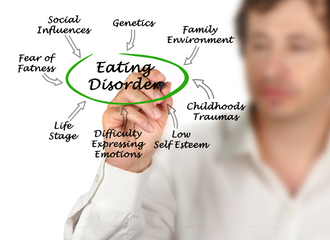Written by: Meghan Brown
Regional Admissions Team Leader, The Renfrew Center of Massachusetts
 Body dysmorphia is a condition characterized by a distorted, and often negative, body image, and the obsessive thoughts and behaviors that are associated with it. In this post, we explore the signs and symptoms of body dysmorphic disorder and what to do if you or a loved one needs help overcoming it.
Body dysmorphia is a condition characterized by a distorted, and often negative, body image, and the obsessive thoughts and behaviors that are associated with it. In this post, we explore the signs and symptoms of body dysmorphic disorder and what to do if you or a loved one needs help overcoming it.
When you imagine someone who is struggling with Body Dysmorphic Disorder (BDD) what do you see? Do you see a person standing in front of a mirror grimacing at their reflection? Do you slide behind their eyes and feel surprised at the different, distorted person staring back?
If you’re concerned that you or someone you love may be struggling with body dysmorphia, you might be wondering how to distinguish between poor body image, self-esteem issues, and a diagnosable mental health condition.
This post is all about helping you navigate.
What Is Body Dysmorphia & Who Suffers from It?
BDD is a psychiatric illness that often co-occurs with other diagnoses like Obsessive Compulsive Disorder (OCD), trichotillomania (picking at skin or hair), anxiety, and eating disorders. BDD is more than just disliking your body or having negative opinions about a body part. It’s normal for people to experience critical thoughts about their bodies from time to time, especially while existing in a culture with completely unrealistic and unattainable beauty ideals. Individuals with BDD, however, are consumed by the thoughts and behaviors associated with this disorder.
BDD is relatively common and affects approximately 1 in 50 people (Anxiety & Depression Association of America). In fact, you likely know someone who is living with it. It tends to first appear in early adolescence, and is marked by persistent, intrusive thoughts focused on one or more perceived flaws in one’s appearance.
Signs & Symptoms: How Body Dysmorphia Affects Behavior
People who are diagnosed with BDD spend a significant amount of time focused on their perceived physical flaws, checking their appearance, and/or avoiding aspects of their lives. BDD’s intrusive thoughts drive people to engage in repetitive behaviors or patterns to manage distressing emotions related to their physical appearance and sense of self-worth.
These behaviors can include comparing their perceived flaw to others, undergoing cosmetic consults and procedures, repeatedly checking their flaws in a mirror, or constantly seeking reassurance from others about their appearance.
The distress, shame and anxiety about their perceived flaws can be so severe that people with BDD might completely avoid situations where their imperfections could be exposed. These symptoms cause significant distress and negatively interfere with functioning across various areas of life, including relationships, school, and work.
How Do I Know if I Have Body Dysmorphic Disorder?
The Body Dysmorphic Disorder Foundation has a test that you can complete to get a gauge on the impact of these intrusive thoughts and behaviors on your day-to-day functioning. It asks questions about how often you’re purposefully checking your reflection, how distressed you feel about your features, how often your appearance concerns get in the way of your life, and more.
If you’re interested in exploring the questionnaire you can find it at the Body Dysmorphic Disorder website here: https://bddfoundation.org/information/do-i-have-bdd-test/
What Should I Do If I Think I Have BDD?
If you’re concerned that you might have BDD, or you have already received a diagnosis, it’s normal to wonder what the next step would be to address the thoughts, behaviors and feelings that interfere with your life.
Some people have tried to address BDD by changing their physical body. In many ways we’ve been socialized to take this approach. The diet, fitness and beauty industries tell us that if we are unhappy with our bodies, we will feel better by changing our external selves. Body image goes much deeper than our appearance on the outside; it is also a combination of internal experiences. It exists in our minds, and therefore must be addressed there, especially if we’re hoping for a healthier relationship with our body and sustainable improvement in our self-worth.
How do you address those internal worries? Therapy grounded in cognitive behavioral techniques can help. The skills practiced in this model focus on the way thoughts, feelings, and behaviors interact. Once you know how they are connected you can identify ways to add in alternative thoughts, explore your feelings, and change your behaviors.
Much of the work is about leaning into anxiety by purposefully approaching the very situations that evoke it. Over time, this type of exposure work can build a sense of emotional tolerance and mastery. If you’re fortunate enough to access mental health services, individual therapy or group therapy can help you learn and practice these skills.
What Should I Do If My Loved One Has BDD?
When a loved one is struggling with BDD it can be confusing, frustrating, and heartbreaking. It’s extremely distressing when someone you care about holds such a distorted and critical image of themselves in their mind.
Know that BDD requires consistent treatment to make progress, and that people who start to address the disorder will likely require time to make significant changes in their day-to-day lives. Hold onto the hope that while BDD does not get better overnight, recovery is possible with the specialized therapy, the support of loved ones, and sometimes medication.
The behaviors that can accompany BDD also have an impact on the people who spend a lot of time with the person who is struggling. As a loved one, you’re allowed to set boundaries with the person who you’re worried about. Talk about reasonable limits to how long your spouse spends in the bathroom in the morning while others are getting ready, or how many times your child changes their clothing before leaving the house. Your loved one isn’t doing these behaviors to annoy or irritate you, and you have the right to lovingly set limits in communal spaces. Creating these collaboratively with your loved one can help everyone work to stick to them.
Your loved one may reach out for reassurance that their perception is off, or that their behaviors are unnecessary. It’s tempting to soothe someone you care about when they’re distressed and doing so consistently will only decrease anxiety temporarily before it comes back full force. You can support your loved one to build their internal self-worth by encouraging them to practice saying the same comforting words they’re seeking from their family or friends.
Conclusion
If you worry that you or a loved one are struggling with BDD, seek out professional and social support. Struggling with BDD can be isolating and make someone feel odd or different. Connecting with professionals who can help and people who are loving and supportive can make all the difference in the recovery process.



